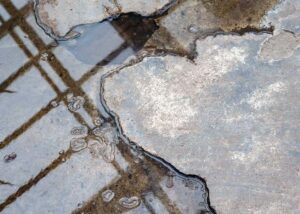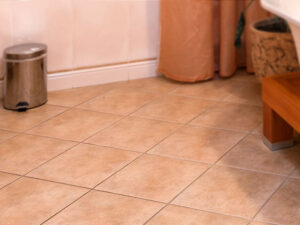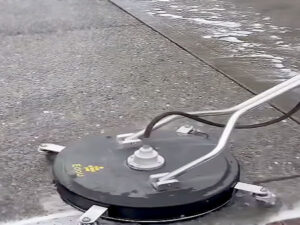Have you ever worked in a restaurant kitchen? Do you know just how quickly grease and dirt build-up on floors? Making the place of work look unappetizing while being dangerous to workers who could slip and fall?
Therefore, it is crucial that you learn how to clean a dirty restaurant kitchen floor effectively and efficiently. Though this task might appear challenging at first, with the appropriate tools and knowledge it shouldn’t take too much effort or time.
In this article, I will describe my experience cleaning restaurant kitchen floors and share what I’ve learned along the way. From which products should be used and the necessary steps that must be taken in order to keep your floor safe for workers.
7 Steps for Cleaning the Greasy Kitchen Floor in a Restaurant
Are You Searching For An Easy Way to Clean the Cooking Floor in a Restaurant? Look No Further! With the appropriate tools and expertise, cleaning a restaurant’s dirty cooking floors in no time is achievable! Here are seven steps that will get the job done:

Step 1: Sweep the floor
Before beginning to clean the floor, pick up any trash, food debris, or solid objects found on it. Use a broom and dustpan to properly sweep it. Multiple sweeps may be necessary in order to collect all the litter on your floors. Make sure that you reach under kitchen appliances as well as corners of your kitchen when doing this task.
Step 2: Use Degreasers
Once your floor has been thoroughly cleaned, add a degreaser as a final step in its care. Degreasers are cleaning products designed to break down oil and grease accumulation on surfaces. There are a wide variety of degreasers on the market. Choose one designed specifically for kitchen floors from any hardware shop or restaurant supply store. Simply follow its label instructions when mixing water into it to use.
Step 3: Saturate the floor with cleaner
Once your cleaner has been mixed with water, you can spread it on the floor using either a mop, sponge or spray bottle. Make sure that it covers every square inch, including beneath appliances and corners. Leaving it there for several minutes will allow it to work its magic!
Step 4: Scrub the floor
After giving the cleaner some time to work, it’s time to scrub the floor with either a brush or machine. It’s scrubbing the floor in circles to ensure all oil and grease have been eliminated from your floors. Be particularly attentive in places that appear dirty. Pay special attention to those areas under appliances or in corners that need extra attention.
Step 5: Rinse the Floor
Once your floor has been thoroughly cleaned, its next step should be rinsing. Use a mop and bucket of clean water to do this task. Be sure to fully rinse every corner and under appliances when performing this step. You may even have to repeat your efforts multiple times until all cleaner is eliminated from the surface.
Step 6: Allow the floor to air-dry completely
Once the floor has been rinsed and rinsed again, it’s time to dry it. A dry mop or squeegee are excellent tools for quickly and thoroughly drying floors. All excess moisture must be gone from the floor so as to avoid people slipping and falling on it. If necessary, use a towel to further absorb any remaining wetness on it.
Step 7: Protect and Finish Your Floor
After cleaning and drying a floor, using a floor sealer is an essential step for protecting it and making future maintenance simpler. Any hardware store or restaurant supply store will sell floor sealers. Just follow the directions on their bottles when applying them to your floor.
In summary, cleaning a dirty kitchen floor in a restaurant might seem daunting but is essential to keeping it safe and hygienic. By performing these seven simple actions you can ensure your floor remains free from grease and oil deposits, which will reduce the likelihood that someone slips and falls.
Can I clean a kitchen floor that has become dirty with ordinary cleaning supplies?
Normal cleaning products shouldn’t be used to tackle a grimy kitchen floor as these might fail to effectively remove grease, leaving an unsightly film that makes the surface slippery and dangerous. Instead, an industrial degreaser designed specifically for oily floors may provide better results.
Strong chemicals used in commercial degreasers help break down grease for easier cleanup. Typically leave it on the floor for some time and then use a brush to scrub any hard-to-reach spots. To ensure people remain safe when walking on this surface, rinse well afterwards with clean water before drying thoroughly.
Soap and water as well as other commonly available cleaning products may not be effective in eliminating grease from floors. Leave an unsightly residue that is both slippery and hazardous to walk on. Furthermore, using such standard cleaners may take longer and take more work than investing in commercial degreasers.
Keep in mind that professional degreasers have potency chemicals that could potentially be hazardous if misused improperly. When using these items, be sure to read and follow all instructions, wear protective gear such as gloves and eye protection, and ensure enough airflow.
Degreasers sold in stores are designed to break down grease and make it easier to clean up. Though their use should still be undertaken with care according to manufacturer directions.
What type of mop should I use to clean a kitchen floor that has become dirty and oily?
When cleaning a dirty kitchen floor, it is essential to use an effective mop tailored for this task. A microfiber mop is an ideal option as it traps and removes dirt, debris, and grease effectively from floors.
Microfiber mops are composed of small fibers cut into many small pieces that enable them to capture dirt and grease effectively. As well as being highly absorbent, meaning they’re great at gathering up water for spot cleanups! These lightweight yet strong fibers also come in handy for handling messy situations when needed!
Microfiber mops offer more than just their cleaning abilities, they’re strong and long-lasting too! Easy to maintain, these eco-friendly tools can be reused over and over again, better for the environment than throwaway alternatives, making microfiber mopping much cheaper in terms of both money and time savings than disposable alternatives.
Follow the manufacturer’s recommendations carefully when using a microfiber mop to clean a kitchen floor. In general, this involves applying water or cleaning solution onto the mop and wringing it out to get rid of extra liquid. Then mop back and forth across the surface in an anticlockwise motion. Rinsing often will also ensure it doesn’t spread dirt and grease onto other areas.
Microfiber mops are excellent tools for cleaning an oily and dirty kitchen floor, soaking up lots of dirt and grease and holding onto it securely for a long. In order to use one effectively it’s essential that users follow all manufacturer instructions closely, and rinse frequently ensuring the mop doesn’t spread more dirt across the surface of the floor.
Is it safe to use a floor scrubber to clean a greasy kitchen floor?
Utilizing a floor cleaner for kitchen floor maintenance is typically safe, though there are a few important considerations you must first keep in mind before doing so.
At first, it’s essential that the floor cleaner can effectively tackle greasy floors. Not all floor scrubbers are designed for handling grease effectively. Therefore, selecting one with appropriate brushes or pads designed specifically to tackle sticky floors may prove fruitful.
Second, when using a floor scrubber, it’s crucial that you follow its manufacturer’s directions. Typically this means adding commercial cleaner to the water tank and setting speed and pressure accordingly. Too much pressure could push grease deeper into the floor surface, making cleaning harder overall.
Thirdly, when using a floor scrubber it’s important to ensure there is sufficient airflow. Otherwise, the machine could create too much dust and waste for its intended use. This can be especially challenging in kitchen environments with plenty of food debris on the floor.
Finally, it’s crucial that all workers know how to clean properly and that the floor is clearly marked off so no one slips and falls.
Overall, using a floor scrubber to clean a kitchen floor should generally be safe; however, it’s essential that you choose an appropriate machine, follow all manufacturer’s instructions, ensure adequate ventilation, and train all workers accordingly if you want your cleaning to go as smoothly as possible without endangering anyone’s health or safety.
How can I keep my kitchen floor from becoming greasy in the first place?
Preventing kitchen floors from becoming dirty in the first place is the key to keeping them cleaner for longer. Here are a few ways you can protect them:
Regular Cleaning: One of the best ways to protect your kitchen floor from becoming dirty is regular cleaning. Make sure any spills or splatters are addressed immediately so grease doesn’t accumulate over time, and then sweep or mop daily to eliminate dirt that might get stuck in grease deposits.
Use a Grease Trap: Consider switching up your cooking methods so as to minimize grease waste in the kitchen. Instead of deep-frying or frying, grilling or baking are great alternatives that help decrease grease production in the kitchen. This will also reduce unnecessary costs associated with maintaining an environmentally-friendly kitchen environment.
Employ Mats: To prevent spills from making their way onto the floor, place mats or rugs strategically in areas of the kitchen that see heavy traffic, such as in front of the stove and sink. This will allow any mishaps from spilling over onto them before they make a mess of things!
Use a degreaser: Regular cleaning with an industrial degreaser will help break down any grease, that has built up over time and restore the floor’s appearance.
Train employees: Train employees how to properly clean, while encouraging them to remain vigilant about keeping the kitchen greasy-free by being aware.
To prevent kitchen floors from becoming greasy in the first place, you need to regularly clean them. Cook in ways that produce minimal grease, install a grease trap, and use mats and degreasers as appropriate. Train staff on proper practices for cleaning kitchen floors and train them as appropriate. By following these guidelines you will ensure a cleaner kitchen in the future and can keep its surface clearer for longer.
Final Thoughts
Cleaning a restaurant kitchen floor requires careful consideration and planning, but by following this guide’s seven simple steps your floor will remain free from grease, and less likely for accidents such as slips or falls to occur.
Starting with setting up the area and gathering all necessary tools, through to sweeping, mopping and drying the floor, each step plays a significant role in ensuring cleaning is carried out quickly and thoroughly. Utilizing tools and products such as cleaners or high-quality mops can ensure all grease or dirt from floors is removed completely from them.
But it is also essential to keep in mind that the key to keeping kitchen floors greasy-free and spotless is prevention. Regular cleaning, cooking methods that don’t leave behind grease on the floor, installing a grease trap, mats, and degreaser applications as well as training employees are all ways you can keep floors from becoming dirty in the first place.
Following these best practices can help ensure the kitchen of a restaurant remains clean, safe, and healthy so customers feel welcome while food can be prepared quickly and effectively.






